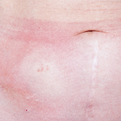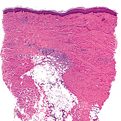Morphea
General Information
Morphea, also known as localized scleroderma is a disorder of thickening, hardening and discoloration on the affected skin. This chronic or recurrent condition is a cause of excessive collagen deposition in the skin and subcutaneous. Unlike systemic sclerosis, morphea does not involve the internal organs. Morphea begins as red patches that gradually develop a white center. This skin disorder is sub divided into five subtypes: plaque morphea, generalized morphea, linear scleroderma, bullous morphea and deep morphea. There is no definitive cure for morphea; treatment is focused on treating the signs, symptoms and slowing down the disorder. Medications prescribed by health-care providers include Corticosteroid, Antimalarial, and Immunosuppressive. Physical therapy can be performed to improve joints. Laser treatments, topical creams, chemical peels and plastic surgery can also be performed to improve the discoloration of the skin.
Epidemiology
25 cases per million populations per year
Etiology
Unknown, linked to family history of autoimmune diseases, anti-histone and anti-topoisomearase lla antibodies, radiation therapy and trauma
Pathogenesis
Skin hardens, thickens and gets some form of discoloration
Clinical
Plaque type condition forms on skin
Histology
Perivascular and interstitial infiltrate of lymphocytes admixed with plasma cells and occasional eosinophils is observed in the reticular dermis and/or the fibrous trabeculae of the subcutaneous tissues.
Bibliography
1. “Morphea” (Online). August 2006. http://www.emedicine.com/derm/topic272.htm (visited: March 26, 2008) 2. “Morphea” (Online). February 2008. http://www.mayoclinic.com/health/morphea/DS00718/DSECTION=1 (visited: March 26, 2008)
Download PDF
![]() Morphea
Morphea


